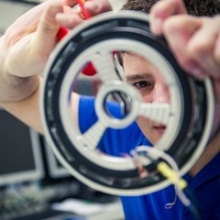The invention precedes the transfer of the research findings to third parties for utilization, i.e. the actual innovation. Inventions are the core task of the universities, as they create new knowledge and technologies - first through basic research in all disciplines and then through applied research and development.
What is IP or intellectual property?
IP stands for “intellectual property”, which means that there are property rights to creations of the human intellect (e.g. inventions, know-how, software). The terms “trademark rights” / “IP rights” comprise all systems of rules that protect these individual intellectual achievements, such as the patent law and the utility model law concerning inventions, and the copyright law concerning works of science, literature, and art (including software).
Research findings are intellectual property; fundamentally, they belong to those who produce them. The University of Stuttgart has set down in an IP strategy [de] how to manage this intellectual property.
The IP strategy is designed to safeguard the interest of all parties involved: researchers, the University itself and its cooperation partners. It makes knowledge and technology transfer possible without putting limits on academic freedom.
The University of Stuttgart offers various possibilities for the economic exploitation [de] of intellectual property, especially inventions, patents and utility models.
Overview of the IP Strategy
- In principle, research findings will be disseminated in a timely manner, especially in relevant professional journals or by registration of IP rights, so that the discoveries achieved are widely disseminated.
- Utilization of research results as the basis for further research and in teaching will be ensured.
- Research results that can be commercialized are to be protected by patent or trademark filings, for example, before being publicized. Until then, they are to be kept under wraps by internal nondisclosure.
- The economic value of research results is to be safeguarded by direct or indirect, self- or third-party commercialization at market rates.
- TTI Technology Transfer Initiative GmbH supports the spinning off of University-spawned startups that develop goods and services based on discoveries made at the University.
- Upgrades of existing cooperative arrangements between individual institutes and companies to long-term partnerships and alliances at the university level will be monitored continuously to reinforce existing research emphases and identify new research priorities.
Internal regulations apply for the realization of the IP Strategy. The regulations can be found in the additional elucidatons Realization of the IP Strategy (german).
Classifying research findings as intellectual property preserves the owner’s rights in intangible goods – for example, research outputs such as inventions, processes, copyrights (e.g. for computer programs), designs and the know-how related to them – whether or not they can be patented or trademarked. Fundamentally, the rights to intellectual property are vested in whoever produces it. If required legally or contractually, these rights may be conveyed to an employer or client on a case by case basis.
With about 1,000 patent applications and patents, the University of Stuttgart has an excellent portfolio of different technologies for numerous industries. The university advises on patentability, patent search, and various trademark rights.
Inventions are creative achievements that must be reported to the university. The University of Stuttgart provides information regarding the obligation to report inventions, patent search, and publication.
A sampler of successful patents and patent filings:
Whether in medicine or DVD players, in production engineering, manufacturing of microchips or cars, hardly any area of daily life today now gets by without laser technology. Among significant recent developments in the technology is the disc laser, which was invented in the 1990s by a work group around Prof. em. Helmut Hügel and Dr. Adolf Giesen in the University’s Institute of Laser Technologies (ISFW) and which has undergone multiple optimizations and enhancements since then.
This new type of laser, revolutionary at the time, is based on a laser radiation source with a broad spectrum of properties. Since it is extremely effective as well as powerful, it is of key importance both for laser makers and users.
- Patent search [de]
Important databases for patent search
Advice on inventions
Department 15 “Knowledge and Technology Transfer” is a central service facility of the University of Stuttgart. It advises on the registration, administration, and commercialization of inventions, on trademark rights, and on other intellectual property, such as software. The range of services extends from advice at an early stage to the negotiation of license agreements.
Contact
Ralf Kaun
Dr.Head of Department
Tobias K. Artzt
Deputy Head of Knowledge and Technology Transfer
Manager Intellectual Property (inventions, trademark rights)



